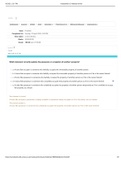Exam (elaborations)
PVL3704 ASSIGNMENT 02 100% SOLUTIONS ( QUIZZ)
- Course
- Institution
THE DOCUMENT CONTAINS ANSEWED MCQ FOR PVL3704 ASSIGNMENT O1 FOR SEMESTER ONE 2023. QUESTIONS DO NOT CHANGE SO USE THIS GUIDELINES BASED ON 100% FEED BACK TO BOOST YOUR YEAR MARK.
[Show more]



